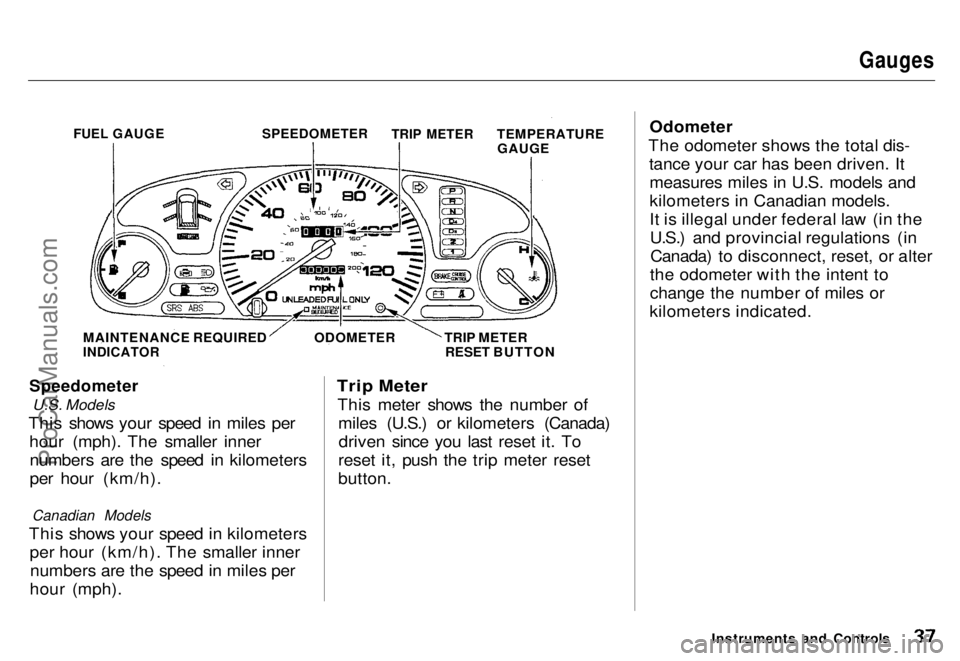1996 HONDA ODYSSEY maintenance
[x] Cancel search: maintenancePage 1 of 240

1996 Odyssey Online Reference Owner's Manual
Use these links (and links throughout this manual) to navigate through this reference.
For a printed owner's manual, click on authorized manuals or go to www.helminc.com.
Contents
Introduction........................................................................\
........................................................................... i
A Few Words About Safety ........................................................................\
................................................ ii
Driver and Passenger Safety ........................................................................\
............................................. 3
Proper use and care of your vehicle's seat belts, and Supplemental Restraint System.
Instruments and Controls........................................................................\
...................................................31
Instrument panel in
dicator and gauge, and how to use dashboard and steering column controls.
Comfort and Convenience Features........................................................................\
.................................73
How t o
op
erate the climate control system, the audio system, and other convenience features.
Before Driving ........................................................................\
.................................................................... 107
What gasoli n
e to u
se, how to break-in your new vehicle, and how to load luggage and other cargo.
Driving........................................................................\
.................................................................................. 117
The proper way t o
start the engine, shift the tr ansmission, and park, plus towing a trailer.
Maintenance........................................................................\
........................................................................ 135
T h
e Ma
intenance Schedule shows you when you need to take your vehicle to the dealer.
Appearance Care........................................................................\
................................................................ 183
T i
ps on cl
eaning and protecting your vehicle. Things to look for if your car ever needs body repairs.
Taking Care of the Unexpected........................................................................\
...................................... 191
This section covers sever
a
l problems motorists someti mes experience, and how to handle them.
Technical Information........................................................................\
...................................................... 215
ID numbers, dimens ions, capacities, and techn
ical information.
Warranty and Customer Relations (U.S. and Canada)..................................................................... 227
A summary of th
e warr
anties covering your new Honda, and how to contact us.
Authorized Manuals (U.S. only)........................................................................\
...................................... 233
How t o
order
manuals and other technical literature.
Index ........................................................................\
......................................................................................... I
Gas Station Information
Information you need when you pull up to the fuel pump.
Owner's Identification Form
ProCarManuals.com
Page 2 of 240

Introduction
Congratulations ! Your selection of a 1996 Honda Odyssey was a wise investment. It will give you years of driving
pleasure.
One of the best ways to enhance the enjoyment of your new Honda is to read this manual. In it, you will learn about
your vehicle's many safety features, and how to operate its driving controls and convenience items. Afterwards, keep this owner's manual in your vehicle so you can refer to it at any time.
Several warranties protect your new Honda. Read the warranty booklet thoroughly so you understand the coveragesand are aware of your rights and responsibilities.
Maintaining your vehicle according to the schedules given in this manual helps to keep your driving trouble-free while
it preserves your investment.When your vehicle needs maintenance, keep in mind that your Honda dealer's staff is specially-trained in servicing the many systems unique to your Honda. Your Honda dealer is dedicated to your
satisfaction and will be pleased to answer any questions and concerns.ProCarManuals.comMain Menu s t
Page 4 of 240

Driver and Passenger Safety
This section gives you important
information about occupant protec-
tion. It shows how to use seat belts
properly. It explains the Supple-
mental Restraint System. And it
gives useful information about how
to protect infants and children in
your car.
Your Occupant Protection System.. 4
The Seat Belt System
and How It Works...................... 5
Why Wear Seat Belts.................... 5
Important Safety Reminders........ 5
Seat Belt System Components..... 6
Lap/Shoulder Belt......................... 6
Lap Belt........................................... 7
Wearing Seat Belts Properly........ 7
Wearing a Lap/Shoulder Belt...... 7
Wearing the Lap Belt.................... 9
Advice for Pregnant Women...... 10
Seat Belt Maintenance................ 11
Supplemental Restraint System..... 12
SRS Components......................... 12
What Happens In a Crash........... 12
Important Facts About
Airbags...................................... 13
How the Driver's Airbag Works........................................ 14
How the Passenger's Airbag Works........................................ 15
How the SRS Indicator Light Works........................................ 16
System Service............................. 16
System Service Precautions....... 17
Additional Safety Information........ 18 Seat-back Position........................ 18
Head Restraint Position.............. 18 Door Locks................................... 19
Storing Cargo Safely................... 19
Driving with Pets......................... 19
Child Safety...................................... 20 Where Should Children Sit?....... 20Important Safety Reminders...... 21General Guidelines for Restraining Children Under 18 kg (40 Ibs) ............... 22
Restraining
an Infant Who WeighsLess Than 9 kg (20 Ibs).......... 22
Restraining
a Child Who Weighs Between9 and 18 kg (20 and 40 Ibs)..... 23
Restraining a Child Who Weighs Over 18 kg (40 Ibs).................. 24
Securing a Child Seat with a Lap/Shoulder Belt................... 25
Using Child Restraints with Tethers............................. 26
Storing a Child Seat..................... 27
Alcohol and Drugs........................... 28 Carbon Monoxide Hazard.............. 29
Safety Labels.................................... 30
Driver and Passenger SafetyProCarManuals.comMain Menu s t
Page 12 of 240

The Seat Belt System and How It Works
If possible, use the lap/shoulder seat
belt, remembering to keep the lap portion as low as possible (see page
7).
Each time you have a check-up, ask
your doctor if it's okay for you to drive and how you should position a
lap/shoulder seat belt. Seat Belt Maintenance
For safety, you should check thecondition of your seat belts regularly.
Pull out each belt fully and look for
frays, cuts, burns, and wear. Check
that the latches work smoothly and the lap/shoulder belts retract easily.
Any belt not in good condition or not
working properly should be replaced.
If a seat belt is worn during a crash,
have your dealer replace the belt and inspect the anchors for damage.
For information on how to clean yourseat belts, see page 187 .
Driver and Passenger SafetyProCarManuals.comMain Menu s t Table of Contents
Page 17 of 240

Supplemental Restraint System
The passenger's airbag is stored near the top of the dashboard, undera lid marked SRS. Do not place any
objects on top of this lid. If the airbag
inflates, those objects can be
propelled inside the car and possibly hurt someone. How the SRS Indicator
Light Works
The purpose of the SRS light on your instrument panel is to alert you of apotential problem with your supple-
mental restraint system.
Have the system checked if: The light does not come on when
you turn the ignition ON (II). The light stays on after the engine
starts. The light comes on or flashes
while you are driving.
If you see any of these indications,
the airbag may not work when
needed in an accident. Take the car
to your dealer promptly for diagnosis
and service.
System Service
Your supplemental restraint system is virtually maintenance-free. There
are no parts you can safely service.
You must have the system serviced by an authorized Honda dealer:
If your airbags ever inflate, the
airbags and control unit must be
replaced. Do not try to remove or discard the airbags by yourself.
This must be done by a Honda
dealer.
If the SRS indicator light alerts
you of a problem. Have the supplemental restraint systemchecked as soon as possible.Otherwise, your airbags might not
inflate when you need them.
When the car is ten years old. Have the dealer inspect thesystem. The production date is on
the driver's doorjamb for your
convenience.
Driver and Passenger Safety
S R S
ProCarManuals.comMain Menu s t Table of Contents
Page 38 of 240

Gauges
Speedometer
U.S. Models
This shows your speed in miles per hour (mph). The smaller innernumbers are the speed in kilometers
per hour (km/h).
Canadian Models
This shows your speed in kilometers per hour (km/h). The smaller innernumbers are the speed in miles per
hour (mph).
Trip Meter
This meter shows the number of miles (U.S.) or kilometers (Canada)driven since you last reset it. To
reset it, push the trip meter reset
button. Odometer
The odometer shows the total dis- tance your car has been driven. Itmeasures miles in U.S. models and
kilometers in Canadian models.
It is illegal under federal law (in theU.S.) and provincial regulations (inCanada) to disconnect, reset, or alter
the odometer with the intent to
change the number of miles or
kilometers indicated.
Instruments and Controls
FUEL GAUGE
SPEEDOMETER
TRIP METER
TEMPERATURE
GAUGE
MAINTENANCE REQUIRED
INDICATOR
ODOMETER
TRIP METER
RESET BUTTONProCarManuals.comMain Menu s t Table of Contents
Page 39 of 240

Gauges
Temperature Gauge This shows the temperature of the engine's coolant. During normal
operation, the pointer should rise
from the bottom white mark to about
the middle of the gauge. In severe driving conditions, such as very hot
weather or a long period of uphill driving, the pointer may rise to the
upper white mark. If it reaches the
red "H" (Hot) mark, pull safely to
the side of the road. Turn to page 202 for instructions and precautions
on checking the engine's cooling
system.
Fuel Gauge
This shows how much fuel you have. It is most accurate when the car is on
level ground. It may show slightly
more or less than the actual amount
when you are driving on curvy or hilly roads. The gauge stays at the same fuel
level reading after you turn off theignition. When you add fuel, thegauge slowly changes to the new
reading after you turn the ignition
back ON (II).
Maintenance Required Indicator
This indicator reminds you that it is nearing 12,000 km (7,500 miles)since the last scheduled maintenance.
Refer to the Maintenance Schedules
for Normal and Severe driving conditions on page 140 . When the distance driven since the
last scheduled maintenance nears 12,000 km (7,500 miles), the
indicator will turn yellow. If you
exceed 12,000 km (7,500 miles), the indicator will turn red.
Your dealer will reset the indicator when he performs the scheduledmaintenance. If someone else
performs the maintenance, reset the indicator by inserting your key in theslot beside the indicator.
Instruments and Controls SLOT
INDICATORProCarManuals.comMain Menu s t Table of Contents
Page 114 of 240

Fuel Economy
The condition of your car and your driving habits are the two most
important things that affect the fuel
mileage you get.
Vehicle Condition
Always maintain your car according to the maintenance schedule. This
will keep it in top operating condition.
An important part of that mainte- nance is the Periodic Checks (see
page 144). For example, an under- inflated tire causes more "rolling
resistance," which uses fuel. It also
wears out faster, so check the tire pressure at least monthly. In winter,the build-up of snow on your car'sunderside adds weight and rolling
resistance. Frequent cleaning helps
your fuel mileage and reduces the chance of corrosion. Driving Habits
You can improve fuel economy by
driving moderately. Rapid acceler-
ation, abrupt cornering, and hard
braking use more fuel.
Always drive in the highest gear that
allows the engine to run and acceler-
ate smoothly.
Depending on traffic conditions, try
to maintain a constant speed. Every
time you slow down and speed up, your car uses extra fuel. Use thecruise control, when appropriate, to
increase fuel economy. A cold engine uses more fuel than a
warm engine. It is not necessary to"warm-up" a cold engine by letting it
idle for a long time. You can drive away in about a minute, no matter
how cold it is outside. The engine
will warm up faster, and you get better fuel economy. To cut down on
the number of "cold starts," try to combine several short trips into one.
The air conditioning puts an extra load on the engine which makes it use more fuel. Turn off the A/C to
cut down on air conditioning use.
Use the flow-through ventilation
when the outside air temperature is
moderate.
Before DrivingProCarManuals.comMain Menu s t Table of Contents